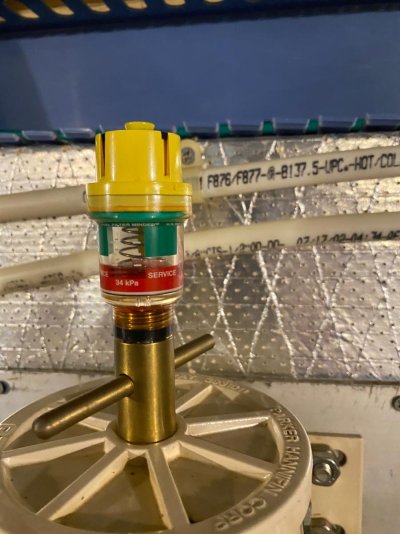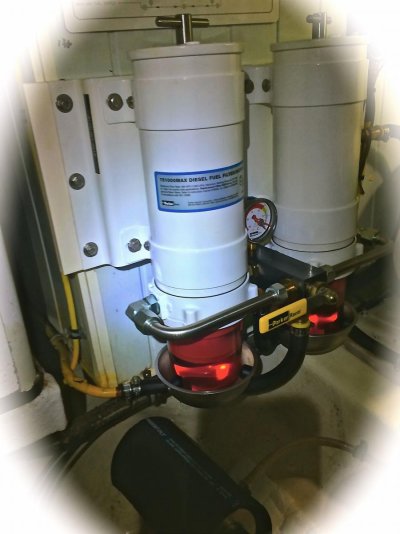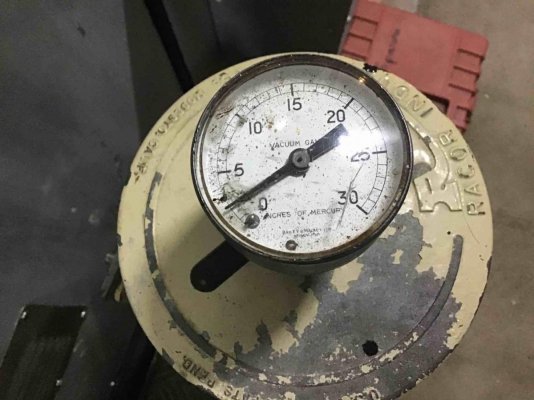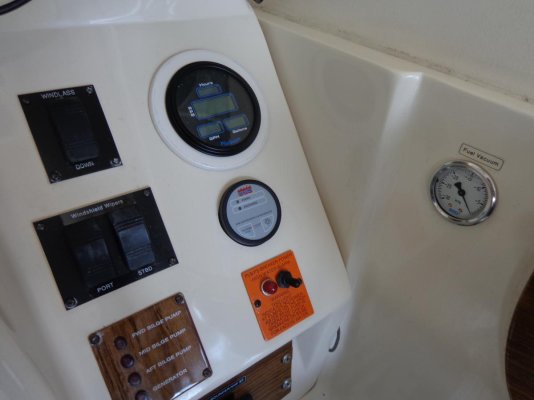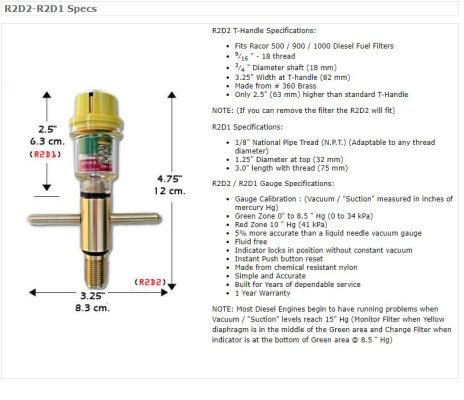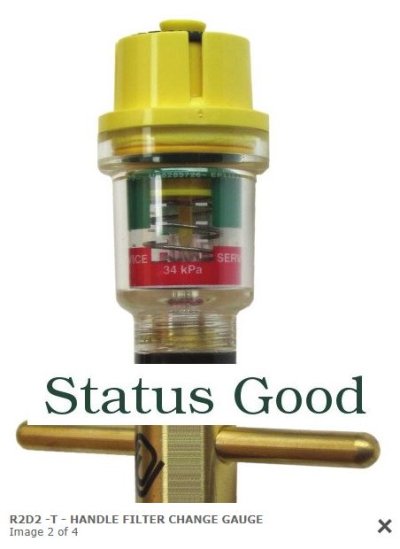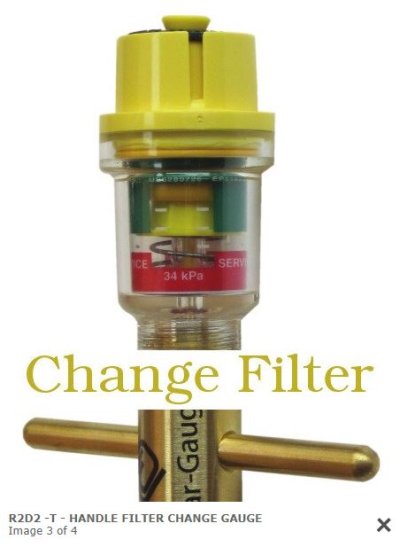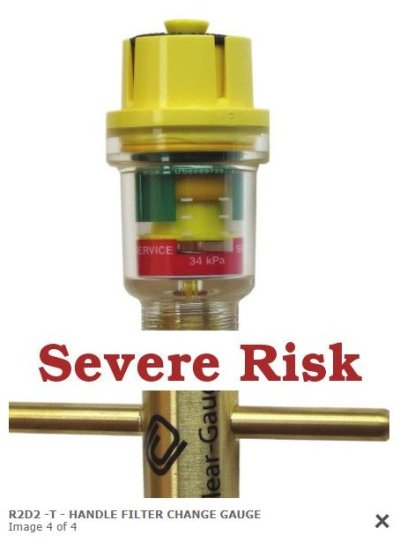You are using an out of date browser. It may not display this or other websites correctly.
You should upgrade or use an alternative browser.
You should upgrade or use an alternative browser.
Understanding Racor Indicator Gauge
- Thread starter Jmreim
- Start date
The friendliest place on the web for anyone who enjoys boating.
If you have answers, please help by responding to the unanswered posts.
If you have answers, please help by responding to the unanswered posts.
GregBrannon
Guru
I found this item. If you do a little more digging using the Racor/Parker part number you may be able to find a manual or page of instructions. Good luck!
Greg.
Greg.
dhays
Guru
- Joined
- May 26, 2015
- Messages
- 9,052
- Location
- United States
- Vessel Name
- Kinship
- Vessel Make
- North Pacific 43
As the vacuum increases a yellow (I believe) ring moves down as the spring is compressed. When the yellow ring gets beyond the green it is time to change the filter.
I had these on my last boat. I changed it to a standard guage where you can actually read the pressure.
I had these on my last boat. I changed it to a standard guage where you can actually read the pressure.
Comodave
Moderator Emeritus
- Joined
- Jul 2, 2015
- Messages
- 21,361
- Location
- Au Gres, MI
- Vessel Name
- Black Dog
- Vessel Make
- Formula 41PC
Racor makes a T handle with a gauge now.
The Jeepster
Member
- Joined
- May 30, 2019
- Messages
- 9
- Location
- New Zealand
- Vessel Name
- Forbes
- Vessel Make
- 1980 Cheoy Lee 55 LRC
yo
Veteran Member
- Joined
- Sep 5, 2011
- Messages
- 82
jmreim
while the engine is running and you are watching the vacuum
gauge shut the fuel line off to the engine, you should see how the gauge changes form green to red.
while the engine is running and you are watching the vacuum
gauge shut the fuel line off to the engine, you should see how the gauge changes form green to red.
OldDan1943
Guru
- Joined
- Oct 2, 2017
- Messages
- 10,599
- Location
- USA
- Vessel Name
- Kinja
- Vessel Make
- American Tug 34 #116 2008
I have the vac gauge, can anyone tell me what pressure they should run at?View attachment 107314
Is is not pressure, it is vacuum in inches of mercury.
Unless you have had your gauge calibrated, it will do.
As the filter gets dirty, the vacuum will increase.
They do make one with a resettable tell-tail red needle so you can see what the max vacuum was while running the engine even after you shut the engine down.
dhays
Guru
- Joined
- May 26, 2015
- Messages
- 9,052
- Location
- United States
- Vessel Name
- Kinship
- Vessel Make
- North Pacific 43
I have the vac gauge, can anyone tell me what pressure they should run at?View attachment 107314
Every system is different. The next time you change your primary and secondary filters, make note of the vacuum when you run the engine. This will be the vacuum created by your clean system. I'd probably replace my filters if I saw vacuum 3"-4" above that baseline.
As others have mentioned, a gauge with a drag needle is really nice. That way you can see what the highest vacuum you reached even while your engine isn't running.
LarryM
Guru
- Joined
- Aug 5, 2011
- Messages
- 1,069
- Location
- USA
- Vessel Name
- Pelago
- Vessel Make
- Wellcraft 3300 Coastal
There is a button on top of the gauge that when pressed, will zero the gauge. In that case, the yellow indicator ring is fully retracted and behind the upper part of the green zone. As vacuum increases, a yellow indicator ring or band will move down and remain at the highest vacuum recorded. After changing the filter(s) press the button on top of the gauge to reset. The Green zone range is 0 - 8.5 Hg. The Red zone is 10 Hg or higher. Depending on where they are mounted, they can be read at a glance, and in my experience are quite accurate.
Attachments
kapnd
Guru
- Joined
- Aug 31, 2013
- Messages
- 881
- Location
- usa
- Vessel Name
- #31
- Vessel Make
- ex-Navy MUB 50 fish/cruise
I was surprised to find that the drag pointer on my boats vacuum gauge was sticking, so it wasn’t recording max drag.
I had to manually move the pointer up to get a real vacuum reading while under way, and it was high!
That’ll teach me to pay attention...
I had to manually move the pointer up to get a real vacuum reading while under way, and it was high!
That’ll teach me to pay attention...
Even more useful, a real vacuum gauge at the HELM. Yup, that gauge to the right side of the pic.
"Yup, that gauge to the right side of the pic"
Did you extend your fuel lines up to the gauge (helm)?
"Yup, that gauge to the right side of the pic"
Did you extend your fuel lines up to the gauge (helm)?
Wow... "fuel lines up to the cockpit" ....
That's REALLY a NO NO! And could argue strongly against that. Things were done that way "years" ago, so I'm sure one could find that set up today.
Got a story....
Rented a plane one day.. it was a POS, just want to get some air time. Flying across the bay, started to smell fuel... WTF.... Finally figured out that the fuel gauge was leaking. (yes, back then, they fed the fuel up into the cockpit for the gauges). Now, fuel is collecting, fumes like crazy. And back then the switches were not spark protected.... so. Touch nothing but land, and fortunately worked out ok. Never rented from that guy again.
Now, gas fumes are much more volatile that diesel... but diesel fumes can burn. Why take the chance. There's plenty of pressure switch that can get the job done... and run a wire to the helm.
TJM
Senior Member
We purchased the newer T Handle Gages RK19671 for our Racor Series 500 only to discover that they are not useable with our low flow Ford Lehmans that sip fuel at 3 GPH. I have 3 of them for sale, brand new.
Steve91T
Guru
- Joined
- Sep 12, 2016
- Messages
- 898
- Location
- USA
- Vessel Name
- Abeona
- Vessel Make
- Marine Trader 47’ Sundeck
We purchased the newer T Handle Gages RK19671 for our Racor Series 500 only to discover that they are not useable with our low flow Ford Lehmans that sip fuel at 3 GPH. I have 3 of them for sale, brand new.
Really? I was just about to buy some for my Lehman’s.
sunchaser
Guru
- Joined
- Apr 9, 2008
- Messages
- 10,200
- Location
- usa
- Vessel Name
- sunchaser V
- Vessel Make
- DeFever 48 (sold)
We purchased the newer T Handle Gages RK19671 for our Racor Series 500 only to discover that they are not useable with our low flow Ford Lehmans that sip fuel at 3 GPH. I have 3 of them for sale, brand new.
Why aren't they usable?
TJM
Senior Member
I was told by the Racor rep that the fuel flow was too low to measure a difference in inlet pressure vs outlet pressure. The product was designed for use in the bigger high flow engines.
Of course, this was after I was asking him why the threaded rod down the center was too long for the 500 series filters. I was not too happy with that either. He said, you just have to cut off about 1/2" and they will work fine.
It has since been added to the install instructions
Of course, this was after I was asking him why the threaded rod down the center was too long for the 500 series filters. I was not too happy with that either. He said, you just have to cut off about 1/2" and they will work fine.

It has since been added to the install instructions
dhays
Guru
- Joined
- May 26, 2015
- Messages
- 9,052
- Location
- United States
- Vessel Name
- Kinship
- Vessel Make
- North Pacific 43
But...but..
Isn't the gauge measuring vacuum? Isn't vacuum...vacuum? regardless of flow?
I don't mean to argue with what the rep said. I just don't understand.
Yeah, that seems odd to me as well.
RichardM
Veteran Member
- Joined
- Mar 23, 2018
- Messages
- 56
- Location
- Canada
- Vessel Name
- Stinkpot
- Vessel Make
- 1985 Hatteras MY 48 - 6V92TA
I was told by the Racor rep that the fuel flow was too low to measure a difference in inlet pressure vs outlet pressure. The product was designed for use in the bigger high flow engines.
Of course, this was after I was asking him why the threaded rod down the center was too long for the 500 series filters. I was not too happy with that either. He said, you just have to cut off about 1/2" and they will work fine.
It has since been added to the install instructions
You're measuring vaccum. Nothing to do with flow. Unless the fuel pump is not capable to generate enough vaccum, which I highly doubt, that needle will start to move once the filter element starts to get dirty.
Cigatoo
Guru
We purchased the newer T Handle Gages RK19671 for our Racor Series 500 only to discover that they are not useable with our low flow Ford Lehmans that sip fuel at 3 GPH. I have 3 of them for sale, brand new.
We have one on our Lehman 135. It moves the vacuum recording needle as filters clog and RPM increase. Seem to work fine. As someone else stated. Vacuum is vacuum.
READY
Guru
I have lehman 120s. 2 sets of dual Racors with vac gauges. They work perfectly fine and you can easily observe the vac increase gradually as the filter elements get loaded. If it increases 3 inches I plan my next filter change. That is probably overkill but the cost and effort to proactively change them is minimal. You can also quickly see the impact if you shut of the incoming fuel supply. In case you screw up at the fuel manifold! I would not have engines without these gauges. I think that rep was full of BS or just untrained.
catalinajack
Guru
What is the point of dual Racors if you change your filters when they are only 1/3 consumed? Why not let the gauge enter the high portion of the yellow, flip the lever to bring the spare on line, and then change the old filter at your leisure? For that matter, what is the point of dual Racors if you have and use a vacuum gauge?
I have lehman 120s. 2 sets of dual Racors with vac gauges. They work perfectly fine and you can easily observe the vac increase gradually as the filter elements get loaded. If it increases 3 inches I plan my next filter change. That is probably overkill but the cost and effort to proactively change them is minimal. You can also quickly see the impact if you shut of the incoming fuel supply. In case you screw up at the fuel manifold! I would not have engines without these gauges. I think that rep was full of BS or just untrained.
rgano
Guru
- Joined
- Oct 8, 2007
- Messages
- 5,000
- Location
- USA
- Vessel Name
- FROLIC
- Vessel Make
- Mainship 30 Pilot II since 2015. GB-42 1986-2015. Former Unlimited Tonnage Master
What is the point of dual Racors if you change your filters when they are only 1/3 consumed? Why not let the gauge enter the high portion of the yellow, flip the lever to bring the spare on line, and then change the old filter at your leisure? For that matter, what is the point of dual Racors if you have and use a vacuum gauge?
What happens to you if your second filter begins to clog because you are suddenly in rough water or whatever? Now you have one clogging and the other, which you are saving to do "at your leisure" already clogged.
sunchaser
Guru
- Joined
- Apr 9, 2008
- Messages
- 10,200
- Location
- usa
- Vessel Name
- sunchaser V
- Vessel Make
- DeFever 48 (sold)
Along with what CJ stated, my single Racor 900 per engine get changed annually or at about 800 - 1,200 gallons. Never once since the vessel was new has a vacuum reading above the gauge bottom occurred.
These filters in a commercial setting will easily handle 5 to 10 times that much normal reputable dealer fuel. The caveat of course is at the low flow rates most of us see, a vacuum reading above "bottom" can indeed occur for a few reasons including:
- fuel tank placement,
- old cruddy dirty tanks,
- high circulating flow rate engines
- very iffy tank to filter lines.
On our vessel, I'm still awaiting a good reason to install a dual first stage filter setup. If I were to choose that path I'd ditch the Racors and go with a Fleetguard setup ala Tony Athen's recommendations.
These filters in a commercial setting will easily handle 5 to 10 times that much normal reputable dealer fuel. The caveat of course is at the low flow rates most of us see, a vacuum reading above "bottom" can indeed occur for a few reasons including:
- fuel tank placement,
- old cruddy dirty tanks,
- high circulating flow rate engines
- very iffy tank to filter lines.
On our vessel, I'm still awaiting a good reason to install a dual first stage filter setup. If I were to choose that path I'd ditch the Racors and go with a Fleetguard setup ala Tony Athen's recommendations.
OldDan1943
Guru
- Joined
- Oct 2, 2017
- Messages
- 10,599
- Location
- USA
- Vessel Name
- Kinja
- Vessel Make
- American Tug 34 #116 2008
What happens to you if your second filter begins to clog because you are suddenly in rough water or whatever? Now you have one clogging and the other, which you are saving to do "at your leisure" already clogged.
+1

READY
Guru
As oregano said it is possible to go from no restriction to major problem very quickly in rough seas or with bad fuel. I have had this happen with older boats/fuel. I prefer to have redundancy on any system possible including the filters. Also I prefer to change the filters at my leisure vs. waiting until it is absolutely required and trying to fit it into my schedule. Just my approach. YMMV
Similar threads
- Replies
- 1
- Views
- 916

